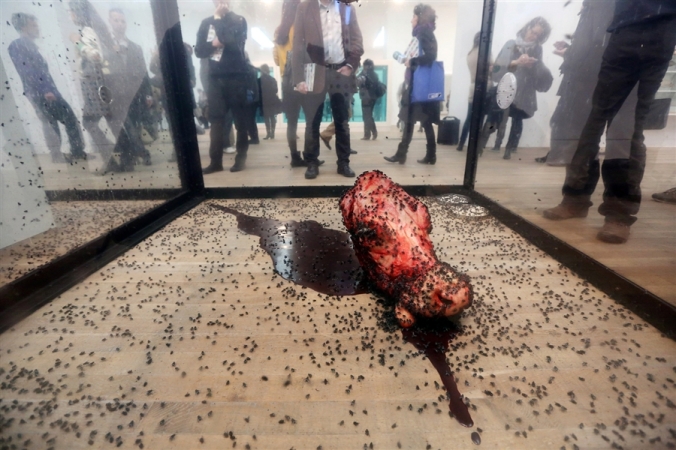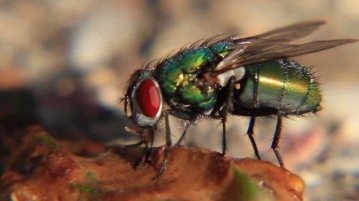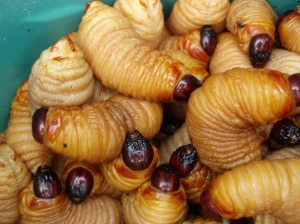My previous post on the science of mirror neurons and the role of kinesthetic or tactile empathy acts as a bit of a prelude to this discussion of Damien Hirst’s two tank pieces which I first introduced in an earlier post, A Thousand Years and Let’s Eat Outdoors Today. I discussed how these installations become abject primarily through their associations with food and rot, but also through their inclusion of death. While these are compelling enough reasons to see the work as abject, to truly understand all of the abject and disgust mechanics at work within these two pieces, I find it necessary to also engage with the idea of tactile empathy put forth in Rokonitz. As explained previously, when we see a purposeful action, the same part of our brain activates as if we ourselves were doing that action. This sympathetic bodily response can, according to Rokonitz, help to understand disgust in works of art. Disgust has already been well established as a knee-jerk reaction being closely linked to the body. It has even at times been understood as a biomechanical or a physiological reflex, a protection mechanism that is beyond the control of our conscious mind. Thus to see someone who is disgusted is to be disgusted, but what happens when we know we should be disgusted, but the actions our brains’ are connecting with are not about disgust?
The role of disgust and how Hirst’s works engage with the abject changes in light of Rokonitz’s work. The viewer of these tanks watches as flies consume the head of a cow. This means that parts of our brain that are engaged for eating are stimulated when watching these creatures. Simply seeing rotten food or the corpse of the cow may not trigger mirror neurons, as seeing objects alone do not cause the neurons to fire in the same way as seeing action. The corpse alone may simply be disgusting. However, seeing the flies’ touch, crawl over, and ingest both the cow and the picnic should cause a paradoxical response in the viewer, a paradox that may be akin to the abject. The abject is the jettisoned that haunts from the periphery, that which we want to be rid of, but need so that we can enact the threat to the ego and the exclusion that reaffirms the ego over and over. This makes the abject paradoxically desirable and undesirable; the ultimate foreign object, but also an intimate piece in the creation of self. Similarly, having part of our brains go off as if we eating in presence of rotted food is paradoxical. By all rights, our brains should view these tanks as threats and we should reject them. However, rejection is not the only thing that happens in the presence of Hirst’s art.
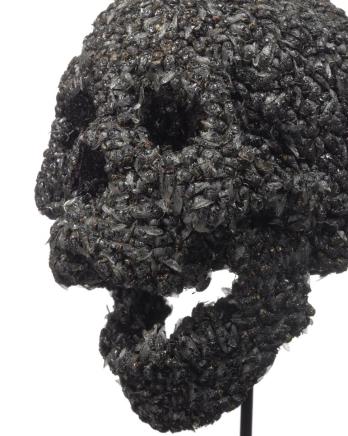
Another of Hirst’s works, a skull covered in dead flies. I would say that this piece may be abject because of it’s association with death and disgust, but does not engage in the same type of mitigation through tactile empathy that the works that involve live flies do.
I argue that part of the mitigation of disgust that happens is through our mirror neuron responses to the flies who rather than representing death, actually offer an antidote to that death in their lively flitting, crawling, eating, and most interestingly copulating and birthing, in the tanks. These works act as small eco-systems that very intentionally provide their inhabitants with sustenance, as well as a means of death, the fly zapper. But in the interim, the life cycle of the fly is lived out in the tank, including the laying and hatching of maggots in the rotted food and carcass. As we watch the flies go about their lives, our own bodies are implicated in their activities.
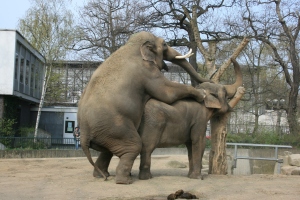
I believe that a similar type of tactile empathy is why we often oggle at animals at zoo’s who are engaged in less that wholesome activities. While sex is of course perfectly natural, it becomes a spectacle because we are both attracted to it as the sex centers of our brains are being stimulated, but must also reject it to appear normal in public. That rejection often comes in the form of a joke or laugh.
This is the paradox of rot, what appears to be dead or dying, is actually full of life, albeit microbic life. This overabundance of life where it should not be is itself disgusting, however, watching life, an action with intention, also stimulates our mirror neurons, firing up an empathetic response in our brains. I believe that this mirror neuron triggered empathy with that which is disgusting but also something more, is one of the hallmarks of the abject. Empathy in the face of threat is the push-pull desire to flee, but to also linger a moment and watch. Rather than the radically excluded that returns, I speculate the abject is that which we ought to, according to rational processes, exclude, but cannot quite jettison. Part of the reason we cannot jettison the abject, or Hirst’s tanks, is because while being disgusted we are also empathetically invested in what is happening, in the life that seems to ooze or burrow its way out of the death in front of us.
